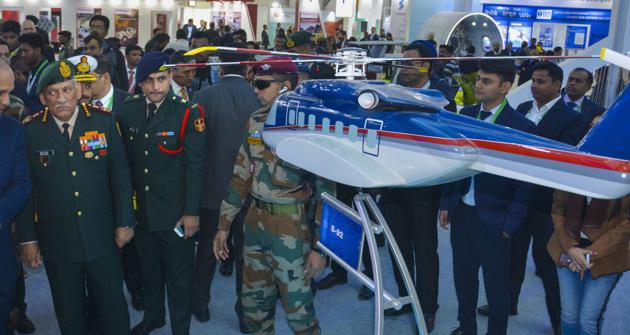The interplay between politics and the military
While the politicisation of the military remains a concern, so is the militarisation of political discourse and practice
In his inaugural address on February 5 at the DefExpo 2020, Prime Minister Narendra Modi set an ambitious and aspirational target for India: “We must ensure defence exports cross ~35,000 crores.” The visual of the PM holding a rifle and taking aim, with a resolute gaze, added to the perception of a leader committed to national security — a theme that Modi repeatedly dwelt upon in his pre-poll campaigning for the Delhi elections. Noting that India had exported military hardware worth ~17,000 crore over the last two years, the PM was, in effect, seeking a doubling of this figure. Realising this target in the stipulated time will be arduous and call for a concerted mission-mode approach. Modi claimed confidently that defence manufacturing would be boosted by the newly-created department of military affairs (DMA), headed by the Chief of Defence Staff (CDS).

Earlier, on February 4, General Bipin Rawat, the first CDS, shared some of his preliminary thoughts with a select group of journalists on the restructuring of the military edifice and, in passing, dwelt on the need to focus on enhancing indigenous defence capacities. Inter alia, the CDS made some other statements that seemed intriguing.
Taken together, the DefExpo 2020, PM Modi’s assertions, and the statements of the CDS point to an anomalous pattern that is evolving in India — the gradual prioritisation of domestic political compulsions over normative national security imperatives. The DefExpo, which showcases India both as a nascent exporter of military inventory and among the world’s top arms importers, was traditionally held in Delhi since inception but from the 9th edition in 2016, the venue has moved to other locations — perhaps related to constituency considerations.
Former defence minister, Manohar Parrikar, moved the expo to Goa in 2016. His successor, Nirmala Sitharaman, shifted it to Chennai in 2018. And now, under Rajnath Singh’s watch, the event has moved to Lucknow. Whether Uttar Pradesh has the requisite ecosystem and infrastructure to emerge as a viable defence manufacturing hub remains moot.
The compulsions of politics were discernible in the first term of the National Democratic Alliance government, wherein the PM was unable to retain a dedicated defence minister despite the earnest statements underlining his commitment to security and defence reforms. Thus in Modi 1.0, India had four incumbents as defence ministers: Arun Jaitley, Manohar Parrikar, Jaitley again, and then Sitharaman. At the time, internal political developments in Goa saw Parrikar assuming charge as Goa chief minister almost overnight.
In the 2019 general election, the Pulwama-Balakot episode allowed the Modi government to project its military resolve as a winning card, and this strategy has been again invoked in the run-up to the Delhi elections. Pakistan is cast as the abiding enemy and more recent domestic political protests over the Citizenship (Amendement) Act have been packaged in an adroit, but potentially dangerous manner, as being “anti-national”, supportive of jihadi terrorism, and an insult to the memory of the brave soldier. In summary — the citizen who either engages in peaceful protest, or decides to vote for a party other than the Bharatiya Janata Party (BJP), is now cast as a security threat and the deplorable exhortation “goli maaro saalon ko (shoot the scoundrels)” is part of the militarisation of the prevailing political discourse. The observations by the CDS, however freewheeling, are perplexing and indicative of this nascent internalising of the political discourse by the military apex. Specific to the fiscal allocation for the armed forces, General Rawat averred that the budget allocated to the military was adequate, and added : “Management of budget is critical. Budget is more a management issue than an issue of adequate funds.”
This goes against the guarded statements made by successive service chiefs for decades that the overall allocation is inadequate to maintain the operational edge that the security environment warrants. It may be recalled that in Modi 1.0, the military inventory inadequacies were highlighted by the parliamentary standing committee on defence, headed by Major General BC Khanduri (retired), a BJP veteran, in 2016. The report cautioned: “It can be averred that the budget cuts leave the possibility of having adverse implications on the country’s security.” Similar cautionary observations were made by the Khanduri committee in 2018 about capital budget allocations for military modernisation. One presumes that General Rawat as the Army chief would have been more than aware of the cannibalisation of major platforms that now prevails in the Indian forces to maintain minimum operational readiness. The prioritisation of the political compulsion was evident in the fact that despite his objective and painstaking review of the inadequacies in the national security apparatus, General Khanduri was eased out of his job. Is there a cue here about the line not to be crossed ?
It is ironical that the anxiety about the politicisation of the military has now been overtaken by the overt militarisation of Indian political discourse and practice . This is undesirable and the PM should take necessary correctives.






